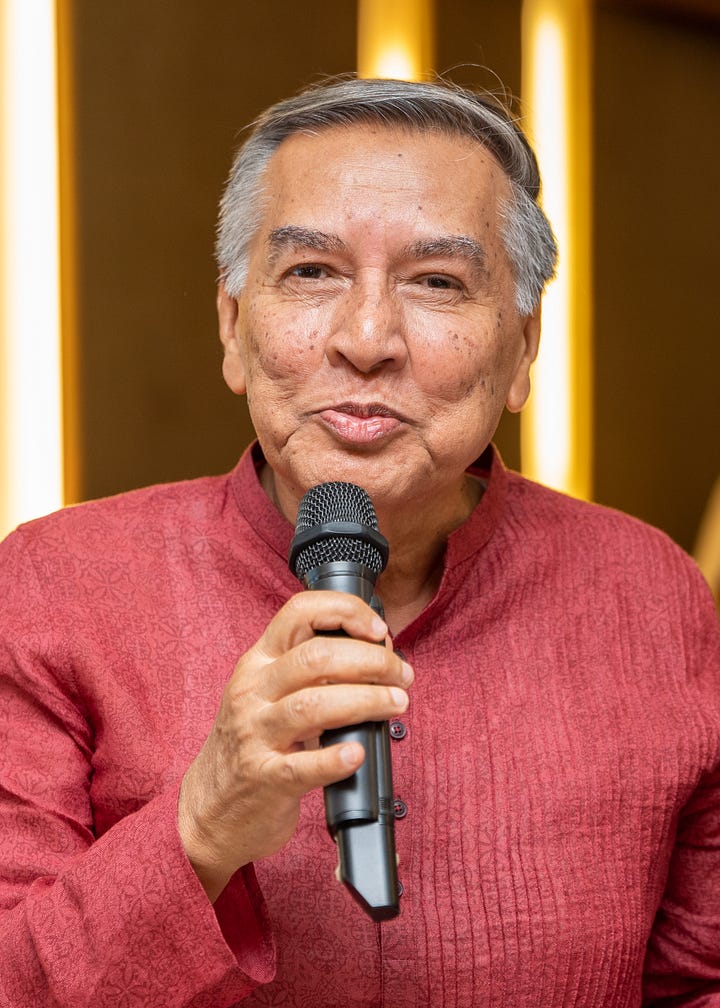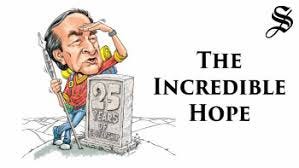Why did Mahfuz Anam fail to foresee Sheikh Hasina's dictatorship?
Anam has needlessly prolonged the 'Battle of the Begums'
The Daily Star is facing protests from a radical section of society who accuse the newspaper of being an agent of ‘Indian aggression’. The Newspapers Owners Association of Bangladesh has condemned the protests and has called on the protestors to “clarify their intellectual stance and views through writing”.
The editor and publisher of The Daily Star, Mahfuz Anam, is the son of an Awami League politician from the 1950s. His father Abul Mansur Ahmad served in Pakistan’s federal government during a time when there was no general election for Pakistan’s federal legislature; while the electoral system was based on ‘separate electorates’ introduced by colonial British authorities which curtailed universal and equal suffrage. Anam regards himself as the scion of the Awami League; a saint who has descended from the heavens to preach democracy, free and fair elections, and press freedom. When Anam’s father was in politics, the Deputy Speaker of the East Bengal Assembly was beaten to death in the first known instance in a Commonwealth country of a parliamentary speaker being killed on the floor of the house.
Anam demonizes the political class with sweeping generalizations of criminality and corruption. His newspaper frequently insinuates against Members of Parliament and even their children. Anam holds enormous power in his hands. The Daily Star is the largest circulating English newspaper in Bangladesh. As a newspaper of record, its editorials often influence government policy. Has Anam used his power responsibly? Or has he prolonged the failed status quo of the Battle of the Begums?
In 2006, Muhammad Yunus outlined his vision for Bangladesh at the 15th anniversary celebrations of The Daily Star. It was clear to everyone at the time that the answer to Bangladesh’s problems will not be solved by either Khaleda Zia or Sheikh Hasina. People were expecting leadership from the eloquent conscious voices of the country who led the intellectual opposition to the BNP’s misrule. While both Khaleda Zia and Sheikh Hasina were democratically elected icons, it was clear that there needed to be a transition to a new generation. Mahfuz Anam could have influenced the course of events by choosing to be magnanimous and organizing the elites towards a new political order. At a dinner in the house of a South Asian diplomat, Anam was apparently teased by the American ambassador for his paper’s circulation. Anam didn’t take that well. Anam could have argued that his paper has a small but influential readership compared to the bigger names in the Bengali press. But instead, he decided to take out his anger on the children of the guests present at that dinner and continues to do so to this day many years later.
Both Yunus and Anam could have taken advantage of the 1/11 changeover to create new political forces. For in Bangladesh’s history, any new political party which has been elected to rule has always been state-sponsored. The Awami League was state-sponsored in 1973. The BNP was state-sponsored in 1979. The National Party was state-sponsored in 1986. When it was clear that Anam and Yunus could not provide that leadership, the army chief Moeen U Ahmed decided to give it a shot and miserably failed (to his credit, Moeen U Ahmed stuck to his two-year timeline and handed power back to civilian politicians in 2008; notwithstanding allegations of corruption involving his brothers and nephews).
Mahfuz Anam chose the easier route. He banked on Sheikh Hasina, whose record in government was already proven between 1996 and 2001. Why couldn’t the Awami League usher in new leadership? Did Mahfuz Anam ever demand internal elections within the Awami League? In the run up to the 2008 general election, Anam was a staunch defender of Sheikh Hasina. The military was seeking to banish both Khaleda Zia and Sheikh Hasina. Anam wrote a critical piece, titled “This is no way to strengthen democracy”. Did Anam ever prescribe a way? Did Anam ever demand free and fair elections within political parties? Elections within political parties are just as much a bedrock for democracy as elections for parliament and local government. Bangladesh’s politics became broken due to the ‘Battle of the Begums’.
Mahfuz Anam got his way. Sheikh Hasina was elected in 2008. Sheikh Hasina presided over an authoritarian regime between 2009 and 2024. The Daily Star, which sang the virtues of democracy while railing against the BNP between 2001 and 2006, did not adopt a similarly staunchly critical editorial line against the League. The caretaker government was abolished in 2011. By 2014, Hasina turned on Anam and her supporters filed over 80 lawsuits against Anam. The person Anam defended as an icon of democracy became a dictator. So, evidently, Anam failed to foresee a dictatorship. It was only in the final years of Hasina’s rule that Anam became a staunch critic.
In the last few years, Mahfuz Anam has been a strident critic of the Hasina government which fell on 5 August. But Anam is a shrewd status quoist who has prolonged the ‘Battle of the Begums’ between Sheikh Hasina and Khaleda Zia by failing to call for new political leadership outside the dynastic realms of these two women. Anam is now showering praise on Tarique Rahman even though his newspaper accused the BNP acting chairman of plotting to murder Sheikh Hasina.
Was Tarique Rahman defamed by the The Daily Star or was the investigative report credible enough for Bangladesh’s law enforcement agencies to press charges? More importantly, why is Mahfuz Anam not calling for new political leadership in Bangladesh? Why is Mahfuz Anam prolonging the failed status quo? Anam is prolonging the stranglehold of the Zia and Sheikh dynasties over Bangladesh politics.
Mahfuz Anam has played his part in building a large than life image for both Sheikh Hasina and Khaleda Zia, while at the same time proving that both women cannot be sustainable leaders for Bangladesh. How long will Bangladesh be stuck in this cycle?
The Daily Star presents itself as a symbol of private enterprise and the free market economy. Oddly enough, the newspaper is silent on how free market economic reforms came about in the late 1970s when the Awami League’s socialist policies were discarded. Anam’s newspaper is now pushing the talking points of businessmen who benefitted from the Hasina regime. The Yunus-led interim government is being portrayed as weak on business, even though Yunus himself is an icon of the free market economic reforms which started after the fall of the Awami League in 1975.


Even though 60% of Bangladeshis believe freedom of expression has improved under Yunus; The Daily Star is engaging in self-censorship and accusing the interim government of stifling press freedom. A curious tactic of The Daily Star is to censor leading young and emerging voices in favor of populist commentators. The ultimate beneficiaries of this strategy are the corrupt elites perpetuating the status quo leadership of Tarique Rahman, Khaleda Zia and Sheikh Hasina. The strategy of the newspaper is to be seen to be progressive but actually being conservative. The Daily Star is being disingenuous. How long will public intellectuals and journalistic elites ally with the anti-bourgeois elements of society against the middle class and political class? There appears to be a conspiracy against the Bangladesh middle class. It reeks of a Soviet and Stalinist conspiracy which is deceiving the people of Bangladesh.
Anam and his newspaper have effectively erased the history of Bangladesh between 1975 and 1990, including the restoration of multiparty politics, the founding of SAARC, and the diplomatic and military contributions of Bangladesh in the Middle East. Anam has a strong dislike for the Jatiya Party, even though ironically, it was the Ershad regime which initiated the process which approved the permit for financiers of The Daily Star to set up the newspaper. Latifur Rahman, one of the financiers of newspaper, was a well-known and key beneficiary of the Ershad regime. At the time, the founding editor of the newspaper was the renowned S. M. Ali. The Grameen Bank was supported by an ordinance from the Ershad regime in 1983, which Anam conveniently forgets.
Anam’s strategy has been to promote the status quoist, zero sum political leadership of the Awami League and BNP. He benefits from the status quo by being the supposedly saintly voice who chides the cynical politics of the Awami League and BNP; even though he himself is prolonging this status quo. This is why his newspaper is promoting Tarique Rahman in keeping with The Daily Star’s status quoist traditions. Anam seeks to demonize anyone who challenges the status quo. His newspaper even advocates the status quo in Israel and Palestine. Ultimately, this strategy is pandering to Bangladesh’s enemies who want the country to fail.






